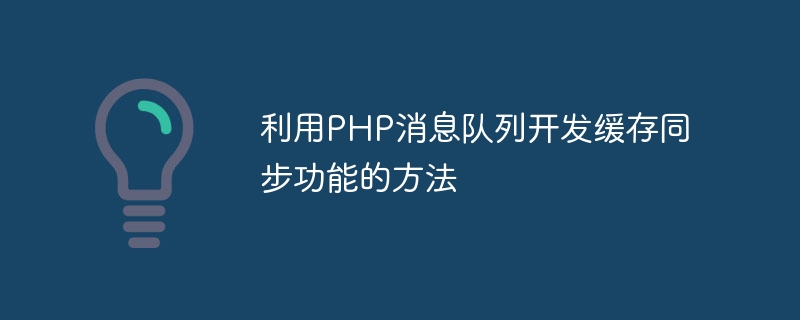Home >Backend Development >PHP Tutorial >How to develop cache synchronization function using PHP message queue
How to develop cache synchronization function using PHP message queue
- 王林Original
- 2023-09-12 12:49:411465browse

How to develop cache synchronization function using PHP message queue
In modern web applications, cache plays a very important role, it can greatly improve the application performance and throughput. However, as applications scale and become more complex, cache synchronization becomes a critical issue. When the cache of one node is updated, the caches of other nodes also need to be updated synchronously to maintain data consistency. And PHP message queue is a common solution.
This article will introduce how to use PHP message queue to develop cache synchronization function. First, we'll look at what message queues are, then discuss how to implement message queues using PHP, and finally how to leverage message queues for cache synchronization in your applications.
- What is a message queue?
Message queue is a communication mode used to deliver messages in distributed systems. It sends a message to a queue, which is then read from the queue and processed by the receiver. By using message queues, senders and receivers can be decoupled, making the application more scalable and maintainable. - Use PHP to implement message queue
In PHP, we can use a variety of ways to implement message queue, such as Redis, RabbitMQ, ActiveMQ, etc. These message queue systems provide APIs to send and receive messages.
Taking Redis as an example, you can use Redis's PUBLISH and SUBSCRIBE commands to implement message queues. The PUBLISH command is used to send messages, and the SUBSCRIBE command is used to subscribe to messages and process them.
First, you need to install and configure the Redis server. Then, connect to the Redis server using PHP's Redis extension. Next, you can use the PUBLISH command to send messages and the SUBSCRIBE command to receive messages.
- Use message queue to achieve cache synchronization
In practical applications, message queue can be used for cache synchronization to maintain cache data consistency of multiple nodes.
When a node's cache is updated, it can send the update operation as a message to the message queue. Other nodes receive and process update messages by subscribing to the message queue to maintain cache consistency.
For example, when a user updates a content item, the update operation can be sent to the message queue as a message, containing the identifier of the content item and the new data. After other nodes subscribe to the message queue, they can receive update messages and update their cached data based on the identifier of the content item.
In order to achieve cache synchronization, the format and content of the message need to be designed. You can use JSON format to define the structure of the message, including information such as node identifiers, operation types, content item identifiers, and data.
When receiving a message, it is necessary to parse the message and perform the corresponding cache update operation according to the operation type. Similarly, mechanisms such as message confirmation, retry, and error handling can also be added to improve the reliability and reliability of message transmission.
- Summary
Using PHP message queue can handle the cache synchronization problem well and improve the performance and scalability of the application. By sending and receiving messages, nodes can update cached data in a timely manner and maintain data consistency.
In practical applications, it is necessary to choose a suitable message queue system and design and implement message format and content according to the needs of the application. At the same time, it is also necessary to consider the reliability and reliability of message transmission and add corresponding mechanisms to handle errors and exceptions.
In summary, using PHP message queue to develop cache synchronization function is one of the important methods to achieve data consistency in distributed applications, which can improve the performance and scalability of applications.
The above is the detailed content of How to develop cache synchronization function using PHP message queue. For more information, please follow other related articles on the PHP Chinese website!

